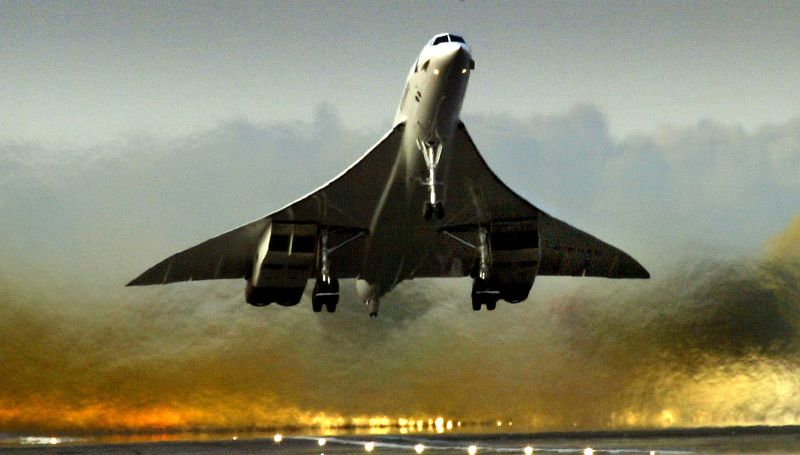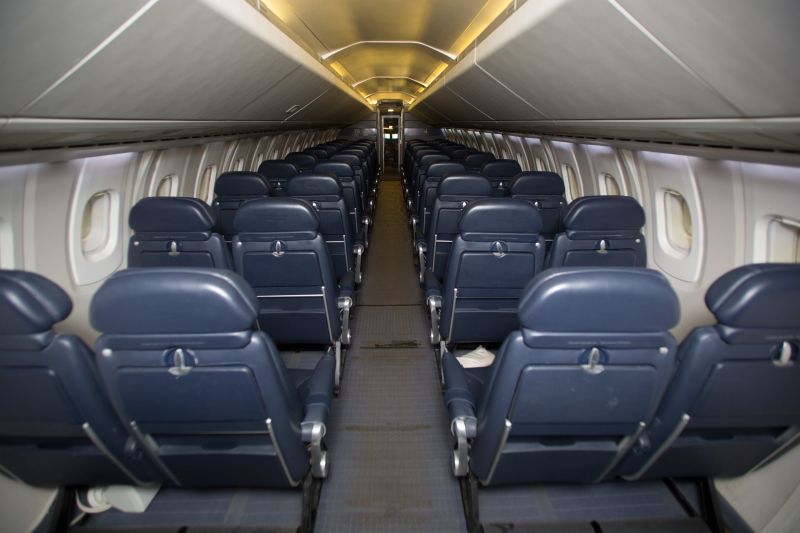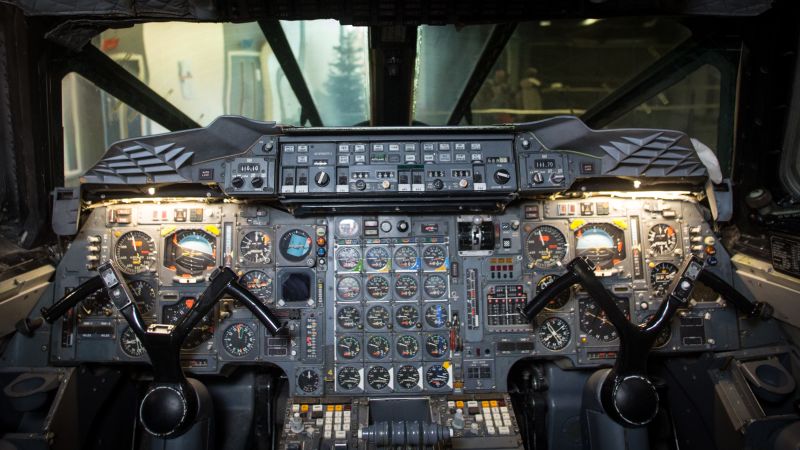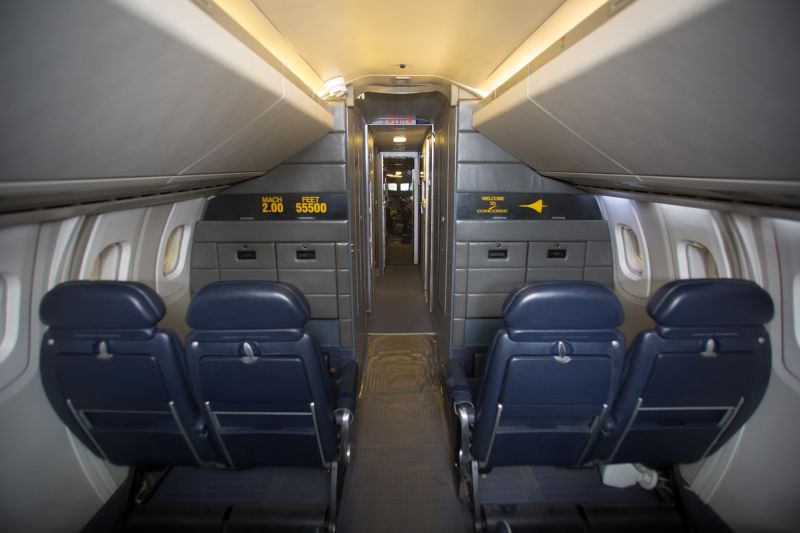
The Last Flight of Concorde: Capturing Aviation's Finest Moment

In 2003, Lewis Whyld immortalized the Concorde's final flight over the iconic Clifton Suspension Bridge in Bristol, UK This extraordinary photograph captures the essence of aviation history and the awe-inspiring beauty of the moment
The supersonic airplane Concorde made its final flight on November 26, 2003, landing at an airfield near Bristol in southwest England. As it flew over the Clifton Suspension Bridge, a crowd cheered, marking a poignant moment for this marvel of modern engineering and the landmark of Victorian engineering.
Perched high in the sky, suspended from a helicopter and battling chilling winds, photographer Lewis Whyld successfully captured a defining image of the golden age of supersonic travel. Now working as an aerial cameraman for CNN, Whyld shares the story behind one of the most remarkable airplane photos ever captured.
The photographers story
I recall hearing someone shout, "There it is, there's the plane!" I was filled with excitement at the sight and immediately snapped a picture. Then it dawned on me, "I have to wait until it's over the bridge."
I believe we were at approximately 3,000 feet, with Concorde flying 1,500 feet below us. I stood on the helicopter skid, feeling the freezing cold and the downdraft from the rotors. My fingers, toes, and face were all numb.
Taking the shot wasn't simple. I had to lean out of the helicopter due to the angle of our flight. I was terrified - not only because it was only my second time in a helicopter, but also because I was afraid of making a mistake on the job.
I had just been hired by South West News Service at the age of 25. This agency supplies images and reports from the southwest of England to national UK and international media. When the Concorde job became available, I quickly volunteered for it. My boss's only advice to me was, "don't mess this up."
3,000 feet in the air
Photographer Lewis Whyld captured this stunning image of the Concorde in 2003 during his inaugural attempt at aerial photography. Accompanied by a friend who was in flight training, Whyld captured this iconic moment from a unique vantage point. Image courtesy of Lewis Whyld.
Being in a helicopter presented numerous potential issues, particularly trying to align everything in three-dimensional space. The likelihood of the plane passing over the bridge at the precise angle we required was slim, compounded by the fact that the plane was moving at a high speed.
In the past, cameras were much slower and I could only take one shot at a time. However, nowadays you can capture a burst of images with just one click.
The plane stood out in the bright sunlight, contrasting sharply against the dark foliage and the river. It would have been simple to overexpose Concorde and end up with just a white triangle devoid of any detail.
Experiencing the Reality of Flying on Concorde
Since the plane was moving at such a high speed and my focal point was extremely narrow, it would have been simple to inadvertently shift focus to something on the ground, resulting in a blurred view of the Concorde.
The helicopter remained in constant motion, unable to hover as we had to fly in circuits to keep it in the air. It was a delicate balance - adjusting the aperture for greater depth of field while being mindful of the shutter speed to avoid blurring from quick camera movements. I found myself making countless adjustments to my camera settings, trying to get it just right before Concorde arrived.
Revisiting the luxury and glamour of Concorde
Capturing the moment
Soaring faster than a speeding bullet, the Concorde continues to hold the title for the fastest commercial flight in history, 20 years after its retirement. Curious to experience what it was like to travel at twice the speed of sound? Browse through the gallery and immerse yourself in the awe-inspiring Mach 2 magic of this iconic aircraft.
Ian Waldie/Getty Images
The fleet of 20 delta-winged aircraft, including the majestic Concorde Alpha Foxtrot, can now be found in aviation museums since they no longer fly. The Concorde Alpha Foxtrot, the final one to be built and flown, is now the main attraction at Aerospace Bristol in the UK.
The interior of Concorde's small cabin was compact, with a seating configuration of only four across and approximately 100 seats available per flight. There was minimal distinction between the Business and First Class sections.
Suzanne Plunkett/CNN
Limited visibility: The windows on Concorde were significantly smaller than those on standard passenger aircraft, but had to endure temperatures as high as 117 degrees Celsius when the plane was flying at supersonic speeds.
Suzanne Plunkett/CNN
Peepholes: The windows look tiny compared to the British Airways livery on the Concorde displayed in Bristol.
Suzanne Plunkett/CNN
The cockpit controls on the Concorde were cramped and lacking in modern digital readouts. The steering controls even bear a passing resemblance to the rocket cycle handlebars from the movie "Flash Gordon."
The bathroom on Concorde was the smallest room and quite a tight squeeze. Su Marshall, a passenger on the airplane, was warned by a frequent flyer to use the restroom before takeoff because the size of the bathroom made it "impossible to pee once in the air."
Suzanne Plunkett/CNN
Concorde cloakroom: Despite the space limitations, there was room for a closet to ensure Concorde's well-heeled passengers wouldn't crease their coats and garments.
Suzanne Plunkett/CNN
Tiny aisle: A view down the aisle from the toilet gives another perspective on the lack of space in Concorde.
Suzanne Plunkett/CNN
Tickets to ride: Flying supersonic came at a price. A London-New York round trip could cost about $10,000.
Suzanne Plunkett/CNN
Experience with benefits: "The flight attendants enjoyed their time on it; the passengers enjoyed their time on it. You were conscious of being part of a very exclusive group of people who were fortunate enough to be on Concorde," according to CNN's Richard Quest, who flew on Concorde five times.
Suzanne Plunkett/CNN
Simple touches: For such an elite aircraft, later Concorde flights used surprisingly simple crockery.
Suzanne Plunkett/CNN
Indulging in fast food at a speed of over 1,500 miles per hour was a delightful experience, offering a menu featuring delicacies such as lobster, caviar, and Champagne. Former passenger Richard Ford attests to the exceptional quality and style of food service.
MARTYN HAYHOW/AFP/Getty Images
Exhibit at Bristol Aerospace showcases a variety of luggage tags from Concorde's short-lived era. Collectors often buy and sell Concorde memorabilia on popular online platforms like eBay. Photo credit: Suzanne Plunkett/CNN
Smoking policies: Reflecting the era in which it was built, Concorde was initially designed to accommodate smokers. However, the ban on smoking in 1997 meant that even cigar-loving tycoons had to extinguish their cigars before boarding. There are reports of a well-known movie mogul getting into trouble for disregarding this rule.
Suzanne Plunkett/CNN
Before the advent of seat-back TV screens, Concorde passengers were informed of the aircraft's supersonic speeds through a digital display on the forward bulkhead.
Switches and dials: Meanwhile, in the cockpit, the pilots relied on simple analog dials and switches to control the super-fast jet.
Suzanne Plunkett/CNN
Supercharged: Concorde was the first, and remains the only, passenger aircraft equipped with turbojet engines featuring afterburners. By directly introducing raw fuel into the exhaust of its four engines, the thrust was immediately boosted by nearly 20%.
Be cautious: The communication between aircraft can be quite fascinating, as mentioned by a former pilot. "We used to alert the slower aircraft as we zoomed past faster than a rifle bullet, in case the sonic boom startled them."
Suzanne Plunkett/CNN
Concorde's four Rolls-Royce engines required specially designed intake vents to slow down the air traveling at supersonic speeds, as jet engines are unable to pull it in at such velocities.
The Rolls-Royce engines on the Concorde were truly remarkable. Former pilot Tye recalls, "Each takeoff was a phenomenal experience, the performance such that we had to warn the passengers in advance what to expect. The roar of the Rolls-Royce Olympus engines, combined with being pushed back into your seat, was like no other civilian aeroplane."
Mario Tama/Getty Images
Close inspection: Visitors to Bristol Aerospace can examine Alpha Foxtrot up close inside and out. It's in remarkable condition for an aircraft that hasn't flown for 20 years.
Suzanne Plunkett/CNN
Bird cannon: Concorde's reinforced cockpit windows were tested by using a cannon to fire raw chickens at them to replicate the affects of bird strike.
Suzanne Plunkett/CNN
Some of the visitors coming to see Concorde in Bristol are former passengers or engineers who worked on it in the nearby Filton aircraft factory, according to its custodians.
Cabin Expansion: The heat produced during supersonic flight caused the outer shell of the plane to expand. During the last flight, the pilot of Alpha Foxtrot managed to wedge his captain's hat between the plane's instrumentation panel and its expanded outer frame, only to have it crushed when the frame returned to its normal size.
Suzanne Plunkett/CNN
The development and operation of Concorde was a collaborative effort between the UK and France. Many involved in the project discussed overcoming language and cultural differences, such as the debate over adding an "e" to the aircraft's name in French. One engineer jokingly referred to it as the "French letter."
Badge of honor: Concorde's name is worn proudly throughout the aircraft. Here it's adorning the side of the tiny galley.
Suzanne Plunkett/CNN
Witnessing history: Passengers aboard the final Concorde flight in 2003 left their mark by signing their names on the interior doors of the aircraft. CNN's Quest described the star-studded event, noting that regardless of their celebrity status, the true star of the show was the plane itself.
The Concorde experience in photos
Prev
Next
There was no trial and error. When it flew by, I would get one chance to take the picture.
In an instant, it appeared, rising in the sky below me. Perched on the helicopter's skid, I leaned out and tugged at the harness, capturing the moment as it flew past the bridge, suspended in the thin air.
I was surprised by the way the photograph captures the shape of the cliff face, the bridge, and the crowd framing the aircraft against a clean background, almost mirroring the shape of the wing. The inclusion of the human element in the photo added an extra level of appeal, as everyone has a fondness for Concorde.
Brunels Suspension Bridge also helped - the engineering triumphs of the 19th and 20th centuries together.
25 of the best places to visit in the UK
After the fly-by, we touched down at Filton airfield, where Concorde had also landed. I snapped more shots of the iconic aircraft being towed into its hangar, with the pilot waving from the window.
Following this, I began editing the images to send them back to the office.
As I brought up the picture of the bridge on my laptop, I remember people looking over my shoulder. At that moment, I had no idea that it was a special picture that would capture people's hearts. All I thought was, "job done." But as more and more people crowded behind me, other photographers started saying, "Why bother sending anything else, when everyone is going to use that one?"
Unaware at the time, I had no idea that it would later prove to be accurate. It was featured in all the newspapers, alongside other images, but that particular one was undeniably the focal point. The image was even produced as a collector's poster, and I enlisted my mom to gather the necessary tokens for us to obtain one. In addition, some newspapers sent me bottles of champagne. It was an experience like no other.
Celebrating the 60th anniversary of the first trans-Atlantic jetliner flight
Enduring image
The image definitely left an impression on aviation enthusiasts. I've received inquiries from several groups requesting assistance in getting Concorde back in the air. Ironically, I believed it would be more beneficial for my photo if the aircraft never took flight again, as it would no longer symbolize the last flight.
It's an amazing machine. I never had the opportunity to fly in it and I have actually never been on it. I only saw it from the outside, below me. That was the first and last time I saw it flying.
In the 20 years since 2003, I've taken other memorable pictures, but you're always remembered for your greatest hits and I suppose that will always be one of my "greatest hits."
The reason for this is partly due to the picture and partly due to the lack of opportunity to take it. Therefore, no matter how great the picture turns out to be, it will always be the final picture of the Concorde. Fortunately, it turned out to be a good one.
I have become quite recognized for my drone footage. This was my first aerial picture, and since then, I have inadvertently established a career niche in taking aerial pictures and using drones.
Despite technological advancements, if we were to redo the Concorde photo shoot, a helicopter would still be necessary. Drones are not allowed to hover over the plane and take pictures. We would use better cameras for the same approach, and I would return with a selection of photos to choose from, rather than just one.
I am somewhat pleased that the technology was limited in some ways, as it means there is only one photo. Nowadays, having multiple versions of an image can diminish its impact. Is there a possibility for Concorde to take flight again?
Changing technology
Concorde Alpha Foxtrot, the aircraft photographed by Whyld, is now on display at Aerospace Bristol.
Suzanne Plunkett/CNN
It is interesting to note that while camera technology has advanced, aircraft technology has not progressed in the same way. In the past, it only took three and a half hours to get to New York. Although we now have larger aircraft such as the A380, the Concorde still remains the epitome of aviation speed.
The photo symbolizes the end of an aviation era, and nothing has arisen to take its place, certainly nothing that has captured the public's imagination like the Concorde. The enduring affection for that bygone era of travel is likely why this picture still resonates today.
I am constantly hearing about the development of new supersonic aircraft, and I am eager to stay updated on any progress. However, nothing definitive has been announced yet. I am hopeful for the return of supersonic travel in a more environmentally friendly and advanced form, which would make global travel more efficient. It would also be a testament to human innovation to witness the return of supersonic aircraft. Unfortunately, I have not seen any substantial progress towards this goal.
If I were to take the photo today, I would have access to a much higher resolution camera, allowing for a wider picture that could be cropped to different compositions. Previously, I used a relatively long lens to capture the full frame for the highest possible resolution. With advancements in technology, we now have the option to use a wider lens and still achieve a high-resolution picture, even allowing for zooming in afterwards, which was not possible at the time.
Vintage British Airways posters commemorate 100 years of aviation. At the time, the prevailing idea was to capture the image with a wide lens, getting as close to the aircraft as possible. However, this would have made the bridge appear small in the background and not achieve the desired effect. Taking a chance, I opted for a long lens, only realizing later that it was quite risky as it meant shooting in a limited space. Fortunately, everything aligned and worked out, but typically, things don't come together so perfectly.
I used to be extremely enthusiastic and confident - I knew exactly what I wanted and believed it would work out without a doubt. As time goes on, I've become more skeptical and realistic. However, I still like to think that today I would take the risk and go for the ultimate photo, rather than playing it safe and ending up with something forgettable.
Now, twenty years later, my photograph has become postcards and posters, and there's even a cross-stitch of it. In the early days, people would often give me gifts like that. I think I have a jigsaw of it somewhere in my house. I've even been asked to do a limited-edition print run.
Thanks to modern technology, we now have the ability to create higher quality prints of photos through advanced editing techniques. While we cannot alter the original camera used to take the photo, we can manipulate and enhance the details through editing. Additionally, having the digital negatives allows us to revisit the raw file and use modern technology to extract previously unattainable details in the digital darkroom.
NASA has initiated plans to construct a new supersonic jet.
Incredible opportunity
Lewis Whyld in 2017, photographing in the Arctic for a CNN project highlighting the impact of global warming.
Courtesy Lewis Whyld
In hindsight, I was truly surprised that Concorde's last flight would be a short trip from London to Bristol. Despite its brevity, it offered our photo agency the opportunity to rival renowned international photojournalists from New York and London. It was an incredible chance to capture a compelling image for a non-political, non-tragic, and non-disastrous story.
I'm glad that one of my lasting memories is something joyful, rather than distressing or catastrophic, like the natural disasters and conflicts I've witnessed. There's something inspiring about the Concorde photo.
Since the last flight, I relocated from Bristol to London. I worked for the UK's Press Association and The Telegraph before joining CNN to capture aerial footage, videos, and drone footage. I was part of the CNN team that covered the Ukraine war, which recently won an Emmy.
The Concorde shot was truly the launching point for my career. It was where everything began. After that, my photos became known and job offers started coming in. It really greased the wheels, propelling my career forward. I never anticipated that when I took the photo, but I'm thankful for it.
This article was originally published on November 26, 2018. It was updated and republished on November 26, 2023.






































